Abstract
The purpose of this study was to determine the true intraocular pressure and modulus of elasticity of the human cornea in vivo. The cornea was modeled as a shell, and the equations for the deformations of a shell due to applanating and intraocular pressures were combined to model the behavior of the cornea during applanation tonometry. At certain corneal dimensions called the calibration dimensions, the applanating and intraocular pressures are considered to be equal. This relationship was used to determine the modulus of elasticity of the cornea and the relationship between the applanating and intraocular pressures. The true intraocular pressure (IOPT) was found to be related to Goldmann’s applanating pressure (IOPG) as (IOPT = IOPG/K, where K is a correction factor. For the calibration corneal thickness of 0.52 mm, the modulus of elasticity E in MPa of the human cornea was found to be related to the true intraocular pressure IOPT in mmHg as E = 0.0229IOPT. The generalization of the Imbert—Fick law that takes into account the effect of corneal dimensions and stiffness was found to be given by IOPT = 73.5W/(K A), where W is the applanating weight in gf (gram force) and A is the applanated area in mm2. The calculated true intraocular pressure and modulus of elasticity were found to agree with published experimental results. The mathematical model developed may therefore be used to improve results from applanation tonometry and to estimate the mechanical property of the cornea in vivo.
Similar content being viewed by others
References
Argus, W. A. (1995). Ocular hypertension and central corneal thickness. Ophthalmology 102, 1810–1812.
Battaglioli, J. L. and R. D. Kamm (1984). Measurements of the compressive properties of scleral tissue. Invest. Ophthalmol. Vis. Sci. 25, 59–65.
Bier, N. and G. E. Lowther (1977). Contact Lens Correction, London: Butterworths.
Chatterjee, A., S. Shah, D. A. Bessant, S. A. Naroo and S. J. Doyle (1997). Reduction in intraocular pressure after excimer laser photorefractive keratectomy. Ophthalmology 104, 355–359.
Ehlers, N., T. Bramsen and S. Sperling (1975). Applanation tonometry and central corneal thickness. Acta Ophthalmol. 53, 34–43.
Friedenwald, J. S. (1957). Tonometer calibration. Trans. Am. Acad. Ophthalmol. Otolaryngol. 61, 108–123.
Fung, Y. C. B. (1967). Elasticity of soft tissues in simple elongation. Am. J. Physiol. 213, 1532–1544.
Gloster, J. (1966). Tonometry and Tonography, London: J. and A. Churchill.
Gloster, J. and E. S. Perkins (1963). The validity of the Imbert—Fick law as applied to applanation tonometry. Exp. Eye Res. 2, 274–283.
Goldmann, H. (1956). In Glaucoma, Trans. 2nd Conf. 1957. F. W. Newell (Ed.), New York: Josiah Macy Jr. Foundation, pp. 167–220.
Goldmann, H. and TH. Schmidt (1957). Über applanationstonometrie. Ophthalmologica 134, 221–242.
Goldmann, H. and TH. Schmidt (1961). Weiterer beitrag zur applanationstonometrie. Ophthalmologica 141, 441–456.
Hansen, F. K. and N. Ehlers (1971). Elevated tonometer readings caused by a thick cornea. Applanation tonometry and central corneal thickness. Acta Ophthalmol. 49, 775–778.
Herndon, L. W., S. A. Choudhri, T. Cox, K. F. Damji, M. B. Shields and R. R. Allingham (1997). Central corneal thickness in normal, glaucomatous, and ocular hypertensive eyes. Arch. Ophthalmol. 115, 1137–1141.
Johnson, M., M. A. Kass, R. A. Moses and W. J. Grodzki (1978). Increased corneal thickness simulating elevated intraocular pressure. Arch. Ophthalmol. 96, 664–665.
Kobayashi, A. S., S. L-Y. Woo, C. Lawrence and W. A. Schlegel (1971). Analysis of the corneal-scleral shell by the method of direct stiffness. J. Biomech. 4, 323–330.
Mardelli, P. G., L. W. Piebenga, M. M. Whitacre and K. D. Siegmund (1997). The effect of excimer laser photorefractive keratectomy on intraocular pressure measurements using the Goldmann applanation tonometer. Ophthalmology 104, 945–949.
Morad, Y., E. Sharon, L. Hefetz and P. Nemet (1998). Corneal thickness and curvature in normal-tension glaucoma. Am. J. Ophthalmol. 125, 164–168.
Moses, R. A. and A. Tarkkanen (1959). The pressure-volume relationship in the intact human eye at low pressures. Am. J. Ophthmol. 47, 557–563.
Mow, C. C. (1968). A theoretical model of the cornea for use in studies of tonometry. Bull. Math. Biophys. 30, 437–453.
The MacNeal-Schwendler Corporation (1995). MSC/NASTRAN for Windows Installation and Application Manual, Version 2.0.
Perkins, E. S. and J. Gloster (1957). Distensibility of the eye. Br. J. Ophthalmol. 41, 93–163.
Schipper, I., P. Senn, U. Thomann and M. Suppiger (1995). Intraocular pressure after excimer laser photorefractive keratectomy for myopia. J. Refract. Surg. 11, 366–370.
Schwartz, N. J., R. S. Mackay and J. L. Sackman (1966). A theoretical and experimental study of the mechanical behavior of the cornea with application to the measurement of intraocular pressure. Bull. Math. Biophys. 28, 585–643.
Sommer, A. (1989). Intraocular pressure and glaucoma. Am. J. Ophthalmol. 107, 186–188.
Whitacre, M. M., R. A. Stein and K. Hassanein (1993). The effect of corneal thickness on applanation tonometry. Am. J. Ophthalmol. 115, 592–596.
Woo, S. L.-Y., A. S. Kobayashi, W. A. Schlegel and C. Lawrence (1972). Nonlinear material properties of intact cornea and sclera. Exp. Eye Res. 14, 29–39.
Young, W. C. (1989). Roark’s Formulas for Stress and Strain, International Editions: McGraw-Hill, 6th Edn., pp. 523, 546.
Author information
Authors and Affiliations
Rights and permissions
About this article
Cite this article
Orssengo, G.J., Pye, D.C. Determination of the true intraocular pressure and modulus of elasticity of the human cornea in vivo . Bull. Math. Biol. 61, 551–572 (1999). https://doi.org/10.1006/bulm.1999.0102
Received:
Accepted:
Issue Date:
DOI: https://doi.org/10.1006/bulm.1999.0102




